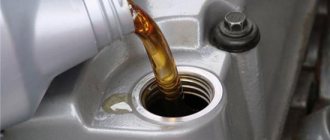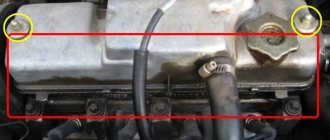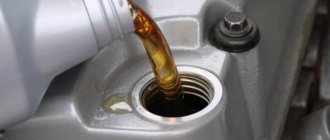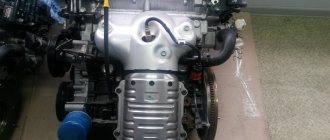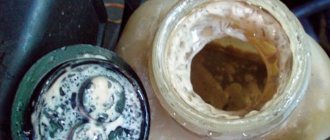Is it possible to pour cold oil into a hot engine?
The engine in a car should ideally function stably and smoothly. The car's handling characteristics depend on how the engine works. In order for the engine to perform its main functions efficiently, it needs good lubrication. The role of lubricant, of course, is performed by automobile oil. The level must be constantly monitored and in the correct position. This information is not new for every motorist, so a competent car owner knows when and how to add oil to his car.
What you need to know before topping up
There are often situations, especially after purchasing a used car, when the new owner does not know how much to top up. In this case, before topping up, you should find out what kind of lubricant is poured into this car. In order not to scour the Internet about this and not look for this information in the user manual, you can clarify this point with the old owner of your car. In addition, the former owner will be able to provide you with information about the frequency of filling engine oil into the engine.
After that, all you have to do is buy the right oil with the right viscosity. Many people are concerned about the question: is it possible to pour cold oil into a hot engine? We will talk about this a little later, since in addition to this issue you need to know what a lack/excess of engine oil in the engine can lead to...
Flaw
If you “oversleep” adding oil, this can have a detrimental effect on the vehicle’s power unit. Many have heard the term oil hunger. This is a condition in which working units and mechanisms do not receive the required amount of lubricant when starting the engine. With a small volume of lubricant, a strong film does not form. As a result, the contacts between metal surfaces will be seriously enhanced, and the crankshaft will function without lubrication. The consequence of this is the formation of fine metal dust, which over time will enter the engine compartment into the oil and this can lead to jamming of the pistons.
Excess
Before answering the question whether it is possible to pour cold oil into a hot engine , you should know what will happen if you overfill the lubricant. Many, especially novice drivers, believe that engine oil should be filled to the maximum. That is, the indicator on the dipstick will be about. This, in their opinion, will only make the car better. However, this is not the case. One of the possible consequences is difficulty turning the engine. This fact is easily explained. After all, any oil has a certain viscosity.
If there is an excess amount of lubricant in the system, excessive resistance is created, causing engine parts to expend more energy when moving. Possible increase in fuel consumption. But this fact is not the most negative. During operation, the oil expands in the engine, resulting in increased pressure. Under pressure, seals such as gaskets and seals begin to deform. Over time, these seals are squeezed out, resulting in leaks. In most cases, the crankshaft seals are affected. As a result, engine parts become dirty.
What oil to add
Of course, ideally this should be the same oil that is currently filled. Ideally, even when replacing, you should not jump from one manufacturer to another, but use one suitable brand. As I have said more than once, when changing, about 10% of the oil remains in the system, that is, mixing occurs, which is not always good.
If after changing the oil there is nothing left in the canister, you can always find liter packages of the same brand on sale. As a last resort, you can add another brand, but with some reservations; I have already written a separate article about this.
Sources used:
- https://dvsoff.ru/obsluzhivanie/mozhno-li-dolivat-maslo-v-goryachij-dvigatel
- https://promotornoemaslo.ru/pro-motornoe-maslo/mozhno-li-zalivat-holodnoe-maslo-v-goryachij-dvigatel/
- https://maslo.expert/wiki/kak-dolivat-maslo-v-dvigatel.html
At what level should the lubrication be and is it possible to pour cold oil into a hot engine
Ideally, the level in a warm engine should be at an intermediate level between the upper and lower values of the dipstick. In this case, the car engine will work without problems.
It is best to check the level in the morning, after idle time.
You can also check the level after doing the following:
- The engine warms up to operating temperature;
- Place the car on a flat surface;
- The engine stops;
- Then wait about 30 minutes;
- The level is checked.
How to check engine oil in winter?
The check must be carried out only on a level surface; tilting the engine forward or backward is unacceptable; If there are no “hot” and “cold” marks on the dipstick, then you need to check it on a warm engine; After you have turned off the engine, let it cool for about 5 minutes.
Interesting materials:
How to withdraw money from an expired card? How to maintain the order of actions in Photoshop? How to shorten an action word? How to make a dog collar with your own hands? How to remove friends' actions in Odnoklassniki? How to remove your actions from your feed in Odnoklassniki? How to delete actions in Google? How to enhance the effects of Roundup? How to make already fried meat tender? How to find out until what date the Vodafone number is valid?
Procedure for adding engine oil
- Open the hood of your vehicle. We fix it with a special foot;
- We find the engine neck, which has the original screw cap. As a rule, the neck is located on the engine cylinder block and has a corresponding inscription with viscosity marking or “Oil Fil”.
- Unscrew the lid. It should be wiped with a clean cloth. Set the lid aside;
- The engine space opens up. We place a funnel in it, which is necessary in order to exclude cases in which oil may spill into the cylinders;
- Fill it gradually in small portions. You need to make stops every 200 grams. Stopping time is approximately 20 minutes. During this time, it will have time to drain into the crankcase, and then into the pan;
- Before continuing to top up, check the oil level on the dipstick. We continue to add lubricant using this technology until the level reaches a neutral position between minimum and maximum. Do not forget to wipe the dipstick with a clean, dry cloth before checking the level.
- You need to remove unnecessary items from the engine compartment area. Screw on the lid;
- After all the above steps, start the engine and let it run for a while until operating temperature.
This completes the procedure!
If a small amount of automobile oil ends up in the engine compartment, there is no need to make a problem out of it. It can only pose a danger if there is a strong smell of burnt oil. This smell can only appear after the car has warmed up. In other cases, spilled oil should be carefully cleaned up with a paper towel or dry cloth.
Is it possible to add engine oil to a hot engine?
Due to the above, we recommend that you do not add engine oil to a hot engine, especially in winter or cold weather. Leave the car for a few minutes, allowing the engine to cool to the optimum temperature.
Is it possible to add oil to a hot engine?
Top up
into a cold or hot
engine.
It is optimal to fill it into an unheated engine
to operating temperature
the engine
is warm or cold, but not hot.
... This can be
, but you need to take into account the correct level on the dipstick on
warm
engine and the temperature of
the oil
that is being added.
- How to work with a level
- Why does the saw cut crookedly?
- How many liters of oil are in the engine
- How much oil is in a walk-behind tractor engine
- How to change the oil in a walk-behind tractor
- How to change the oil in a snow blower
- How much oil is in Gazelle 5 mortar gearbox
- How much oil is in the gearbox
- How much oil is in a Kamaz engine
Is it possible to check the oil level while it is hot?
How to check the oil level
?
You can check
both cold and
hot
- you won’t notice much of a difference.
What happens if you pour cold oil into a hot engine?
You must immediately remember that if you fill
cold oil
into
hot
engine , this can lead to serious malfunctions.
As a result of a sharp change in temperature, cracks may appear on some engine parts and the geometry of the engine
.
What happens if you don't add oil to the engine?
What will happen
what
if there
is little
oil
in
the engine ?
Will be
bad!
... As a result, the oil
may decrease, and some parts will begin to run dry, remaining without lubrication.
The longer you “ don’t
oil
level , the more
will be
on all the rubbing elements of the engine.
How often should you check the engine oil level?
On modern commercial vehicles, the instructions indicate - “ Check
daily".
Modern foreign cars require checking
the engine oil
level .
Depends on the frequency of use of the car and the daily mileage. In some cases, checking
once a week is sufficient.
Do I need to tighten the dipstick when checking the oil?
Unscrew it by hand counterclockwise and wipe it with a rag or paper towel. Then push it back into the hole until it touches the threads. At this stage, tighten
it is not
needed
.
After this, carefully remove the dipstick
and check
the oil
.
How much oil should I add to the engine if there is a minimum on the dipstick?
When
If you completely change
the oil
in the engine, it is very easy to determine the volume required for filling - just look in the car’s operating instructions. For passenger cars, this volume ranges from 3 to 4 liters. Usually one canister is enough, and even a little is left for refilling.
Is it possible to add oil to the automatic transmission?
Add oil to the box
simple enough. Place a funnel in the neck where the dipstick was (it is better to use a long funnel, it will be more stable). Carefully pour the required volume of petroleum product into it. It is recommended to pour lubricant in portions to avoid overfilling.
Add oil to hot and cold engine
New car owners often ask whether it is possible to add oil directly to a hot engine. Others who are more stubborn will answer that it makes no difference which motor the lubricant is poured into. After all, this is oil, it will not evaporate if you pour it into a hot power unit.
However, experienced mechanics think completely differently. And their judgments are based on practice. Therefore, it is worth listening to them. Let's look at whether it is worth adding lubricant to a hot engine or not, and how to do it correctly.
- How to add oil correctly
- Add to cold engine
- Add to a hot engine
- Features of adding oil in winter
- Conclusion
How to add oil to the engine: in winter, in summer, in a cold or hot internal combustion engine
Let's start with the fact that adding lubricant is often done when it is cold. It is added to a cold engine because it is easier and faster to determine the required level, that is, to avoid possible underfilling or overfilling of lubricant.
As practice shows, in winter, especially in severe frosts, it is best to first warm up the engine, then give it time to cool, and allow the lubricant to drain and “settle.” Such preheating will allow the highly thickened lubricant to return to its proper fluidity.
After this, the engine cools down, but the lubricating fluid still remains diluted, that is, the level can be determined quite accurately. Next, topping up is done; the existing lubricant in the internal combustion engine and fresh lubricant are easily mixed into a homogeneous mass.
However, it also happens that you have to add oil to a hot engine (for example, when the oil pressure warning light comes on) while driving. This situation is quite common and becomes the reason for questions of the kind that would happen if the driver added cold oil to a hot engine.
In this case, it is important to take into account not only the correct level, but also what temperature the lubricant is that is being added. You should also pay attention to the volume to which such topping occurs. For a better understanding, let's imagine a standard situation when a car owner was driving along the highway, the engine was warmed up to operating temperatures, but then the low pressure light in the lubrication system came on.
Naturally, the driver stopped, turned off the power unit and discovered a low oil level. Then he immediately took a canister out of the trunk and added a liter of oil to the engine. If this happens in the summer, then the main risk will be perhaps overfilling or underfilling in level, that is, inaccuracy as a result of topping up “hot”. But if it happens in winter, then the situation is somewhat different.
It is not difficult to guess that the lubricant in the trunk will be very cold, that is, when poured into a warm engine, a strong temperature difference will occur. If, at the same time, not 50-100 grams of such lubricant are poured, but a whole liter or more, then the consequences can be unpredictable.
We also recommend reading the article about what will happen if you pour oil into the engine. From this article you will learn about the possible consequences of exceeding the permissible level of engine oil in the engine.
Experts note that in such a situation, the risk of not only exceeding or underfilling the level increases significantly, but also the appearance of cracks in the block, head, parts, as well as other defects in relation to individual elements of the internal combustion engine. Taking into account the above, it becomes clear why the engine needs to be given time to cool before adding lubricant, and this is especially important in winter.
How to add oil correctly
For now, we will not consider which engine: cold or hot, pour lubricant into. First of all, choose a flat area to fill with lubricant if the procedure will be carried out in a garage. If you take your car to a service center, you don’t have to worry about filling the oil incorrectly. Experienced mechanics will do everything as expected.
After a level area has been selected, open the hood of the car and allow the power unit to cool.
Attention! Remember that too much oil is just as dangerous as too little. Overfilling the lubricant leads to squeezing out the seals and disrupting the operation of the valves.
Now about the brand of oils. It is necessary to use only high-quality lubricants that are sold in specialized auto stores. It is not recommended to buy oil with an expired expiration date, without a label on the package, or with questionable blurry text on the label.
Also, oils should not be mixed with each other. You cannot buy lubricant with parameters higher or lower than those specified in the manual. There are three types of lubricants:
- mineral. They are made from thermal processing of petroleum;
- synthetic. Formed after the synthesis of long molecules from gaseous hydrocarbons;
- semi-synthetic. Made from mineral and synthetic oil by mechanical mixing and processing.
Chemical interaction of oils with each other
It is customary to distinguish oils based on their carrier base:
- mineral. They are based on thermal oil processing products. Depending on the origin of the fossil, the amount of saturated hydrocarbons (paraffins) present may vary. It is generally accepted that a significant amount of them in the composition may limit the period of use of motor oil based on them;
- synthetic are products of the synthesis of long molecules from gaseous hydrocarbons. A distinctive feature is that the composition of the carrier liquid is a liquid in which one type of fat predominates. They maintain high fluidity over a wide temperature range. The load-bearing capacity of the film is quite high, a layer 40 microns thick can withstand loads of up to 2...4 MPa. Food for thought. Mineral lubricants are usually guaranteed to withstand 0.5-1.5 MPa ;
- semi-synthetic oils are created by mechanically mixing mineral and synthetic liquid components. The proportion of mineral components usually does not exceed 30...35% by volume.
Can oils be mixed with each other? Car manufacturers usually remain silent on this issue. At service stations the answer is unequivocal, which is undesirable. In fact, if the situation is such that the lubricant level is below the minimum level, then you can add any engine oil to the crankcase.
Attention! You can only top up with something new and clean. Under no circumstances should work be done.
Objections are possible. Do not mix synthetics and mineral fats. However, it should be remembered that this is the mechanical mixture used in semi-synthetics.
How to add oil when it gets low
The need for topping up is determined in the following ways:
- When checking the level with a dipstick, a position below the MIN mark is observed. You need to estimate the amount of fresh lubricant that will be needed to bring the readings to normal;
- when an icon appears on the information display indicating a decrease in oil pressure in the system. The oiler lights up red on the dashboard information display. In older car models, the pressure arrow shifts upward very reluctantly as the speed increases.
The approximate amount of lubricant that needs to be poured into the engine can be calculated using the data in the attached table. For each mm of level on the dipstick, you need to add the suggested measure. You should be guided by the readings that can be obtained from the measuring ruler of the canister. Modern containers have a transparent layer and a ruler. They will make the work of the car enthusiast easier.
- You need to take any rag or napkin. Clean the filler plug. A significant amount of contaminants can accumulate there.
- It is advisable to wear cotton work gloves (putting several pairs in the trunk will not hurt anyone).
- The plug opens. Its opening does not pose any danger. The pressure in the crankcase and the environment is balanced through the breather, which is discharged into the air filter.
- A funnel is required. Then oil drops will not end up on the surface of the engine. It can be quickly cut from a plastic bottle. The neck diameter of most engines is slightly smaller than 21 mm (the diameter of the threaded part of most plastic bottles).
- The approximate amount is poured into the motor.
- The level is checked 3...5 minutes after filling. All poured oil will flow down the walls into the oil pan.
Attention! Be sure to wipe the dipstick after each check.
Table 1: Amount of engine oil to fill into the crankcase
| Engine displacement, cm³ | It is necessary to add to compensate for 1 mm on the dipstick, ml | Engine displacement, cm³ | It is necessary to add to compensate for 1 mm on the dipstick, ml |
| 500 | 4,6…5,1 | 1800 | 40,8…41,6 |
| 600 | 6,6…7,0 | 1900 | 44,6…45,0 |
| 700 | 8,3…9,0 | 2000 | 48,8…50,0 |
| 800 | 10,3…10,9 | 2100 | 53,1…54,0 |
| 900 | 12,5…13,3 | 2200 | 57,4…58,2 |
| 1000 | 15,0…15,8 | 2300 | 61,8…62,6 |
| 1100 | 17,8…18,6 | 2400 | 66,4…67,1 |
| 1200 | 20,1…21,5 | 2500 | 71,1…71,9 |
| 1300 | 23,4…24,1 | 2600 | 75,9…77,1 |
| 1400 | 27,4…28,2 | 2700 | 80,8…82,2 |
| 1500 | 29,7…30,5 | 2800 | 85,9…87,1 |
| 1600 | 33,3…34,4 | 2900 | 91,1…93,3 |
| 1700 | 37,0…38,0 | 3000 | 96,4…98,3 |
How long can you drive with a refill of another brand?
If topping up is done with engine oil of a different brand than the one poured into the crankcase. Considering that the volume of topping up is usually small, you can drive up to 500...1500 km (the level is controlled by the dipstick readings). In the future, it is advisable to change the engine oil.
Attention! Most car manufacturers indicate in the maintenance card the replacement mileage of 15...20 thousand km. Under operating conditions on domestic roads, it is desirable to reduce the replacement frequency to 10 thousand km. Then the engine service life will not decrease.
The operation of engines under starting and braking conditions in urban conditions leads to overheating of power plants. During a sudden start, which often happens in traffic conditions on the road, some of the fuel does not burn. It enters the crankcase, diluting the existing oil. Viscosity decreases, and the load-bearing capacity of the oil film also decreases.
Features of adding oil in winter
In winter, the risk of cracks appearing on a hot engine when pouring cold lubricant increases. Therefore, topping up must be done in a warm room, in a garage, but not outside at a temperature below 10 degrees minus.
In general, experienced mechanics advise changing the engine lubricant at service centers. Since in these hangars the temperature is always maintained appropriately and no distortions in the engine due to temperature differences will occur.
Is it possible to add oil to a hot engine?
Adding motor oil to a car engine is a fairly simple procedure that does not require attention to detail; therefore, any car owner can carry it out independently, while saving on servicing at a car service center.
Some cars have an electronic monitoring system that shows the oil level on the dashboard, but for most vehicles you will still need to reach under the hood and check the oil level with the dipstick. In this article you will learn how to care for your car between maintenance and avoid engine problems.
How to properly add oil to an engine
There is always a need to add engine oil to the engine. For engines that have driven more than 100 thousand km, wear is such that for every next thousand you have to replenish up to 50...100 ml of lubricant. How to properly add lubricant consumables? Is it possible to add cold oil to a hot engine? These and other questions are often asked by novice motorists on various forums.
Often, even from experienced drivers, you can hear recommendations on the technology of adding lubricant to the engine crankcase. They advise warming up the oil. A dozen reasons are given for which the incompatibility of hot and cold liquids is revealed. I believe that this issue needs to be looked into.
A brief introduction to the thermodynamics of the lubricant mixing process
The school course on molecular physics examines the question of how homogeneous liquids of different temperatures are mixed. Students are asked to independently derive the formula that determines the final value of heating the mixture:
where T₁ is the temperature of the first component, K;
Т₂ – temperature of the second component, K;
Tav – average temperature of the mixture, T;
m₁ – mass of the first component, kg;
How to check the oil level in a car engine?
- To take accurate readings, the vehicle must be parked on a level surface. If you have just completed a trip, wait about 5 minutes before proceeding with the check. If you start checking immediately after stopping the car, you risk getting inaccurate readings. Some automakers require that the oil be checked after the engine has warmed up for 2-5 minutes. This requirement is relevant for all cars in winter, when thickened lubricant needs to be restored to fluidity by preheating.
- To avoid unexpected problems, check your oil every month, or more often if you drive long distances.
- Never carry out the test while the engine is running.
- To check the oil level, open the car hood and locate the plastic dipstick handle. If you are not sure where it is located, consult your vehicle's owner's manual. Once you find the dipstick, remove it and wipe it well - you should see 2 marks on the clean dipstick for the maximum and minimum oil levels.
- Insert a clean dipstick and pull it out again. Inspect where the level of the oil mark appears in relation to the levels on the dipstick. If the oil line is in the middle of the minimum and maximum marks, topping up is not required; if below the middle, we recommend adding a little; if it is close to the min level on the dipstick or below it, you must add lubricant.
The engine eats oil - this is a symptom of engine failure
Increased oil consumption, which is approximately 1 liter per 2000 kilometers, may indicate various engine breakdowns. If you see that the oil level has begun to drop, it is recommended not to ignore this problem, but to conduct a thorough engine diagnostics, which will solve the existing problem.
Oil can leak for various reasons. The most common is the appearance of cracks in the cylinder head, as a result of which antifreeze gets into the oil and characteristic blue smoke appears, which indicates oil combustion.
The car owner added oil to the engine of a different brand and now the lubricant has lost its characteristics.
Also, leaks can appear due to leaky gaskets, which requires hiding the engine and changing the weathered gaskets and rubber bands. Despite the apparent simplicity of such work, such repairs have a high cost, which is explained by its labor intensity.
Oil loss can also be caused by faulty boost turbines. Such turbocharging significantly increases the operating temperature of the engine, as a result, the oil begins to coke, the channels become clogged, and the car owner has to frequently add lubricant to the engine. This problem can be solved by opening the engine and overhauling it.
In some cases, oil loss may occur due to the design features of the engine. Some automakers even set an oil consumption rate of 1 liter per 3,000 kilometers, as a result of which service stations simply refuse to repair a car if it has such problems.
Is it possible to add oil to a hot engine?
Sometimes situations happen when a driver discovers a low oil level on the road, and this is the source of the frequently asked question: “Can I add oil to a hot engine?”
In answering this question, we must note that when adding oil to a hot engine, you will not be able to correctly assess the oil level in the internal combustion engine. If topping up occurs in the summer, the worst that can happen is that you add too much or too little oil. The situation is different with topping up in winter.
In winter, the engine oil in the canister will obviously be quite cold, so pouring cold fluid into a hot engine can cause a temperature difference. It’s one thing when only a small amount of lubricant is added, but another thing when the volume of addition is a liter or more. In the latter case, the result may be unpredictable. Not only will you not be able to correctly estimate the volume of oil required for topping up, but you will also significantly increase the risk of cracks and deformations in the cylinder block, and the appearance of defects on moving and other parts of the internal combustion engine.
Due to the above, we recommend that you do not add engine oil to a hot engine, especially in winter or cold weather. Leave the car for a few minutes, allowing the engine to cool to the optimum temperature.
Motor oils and all necessary auto parts can be purchased at the IXORA store, and professional managers can select the appropriate part.
| Manufacturer | Detail number | Name |
| RAVENOL | 4014835722699 | Engine oil RAVENOL FO SAE 5W-30 (4l) new |
| RAVENOL | 4014835722897 | Motor oil Ravenol Hps SAE New, 5W-30, semi-synthetic, 4L |
| RAVENOL | 4014835722958 | Motor oil Ravenol Hcl SAE New, 5W-30, synthetic, 5L |
| RAVENOL | 4014835723054 | Motor oil Ravenol Hls SAE New, 5W-30, synthetic, 5L |
| RAVENOL | 4014835722590 | Motor oil Ravenol Super Fuel Economy sfe SAE New, 5W-20, synthetic, 4L |
| RAVENOL | 4014835723511 | Engine oil Ravenol vsi SAE New, 5W-40, synthetic, 1L |
| RAVENOL | 4014835723993 | Motor oil Ravenol Hcs SAE New, 5W-40, synthetic, 4L |
| SHELL | 550040295 | Motor oil Shell Helix HX8, 5W-40 SN Plus, 4L |
| SHELL | 550040424 | Motor oil Shell Helix HX8, 5W-40 SN Plus, 1L |
| SHELL | 550040312 | Motor oil Shell Helix HX7, 10W-40 SN Plus, 1L |
| SHELL | 550040428 | Motor oil Shell Helix HX7 Diesel, 10W-40, 4L |
| SHELL | 550040315 | Motor oil Shell Helix HX7, 10W-40 SN Plus, 4L |
| SHELL | 550040462 | Motor oil Shell Helix HX8, 5W-30, 1L |
| SHELL | 550040558 | Motor oil Shell Helix Ultra Diesel, 5W-40, 4L |
| CASTROL | 153BE1 | Motor oil Castrol Edge Titanium FST, 5W-40, synthetic, 4L |
| CASTROL | 156EDD | Motor oil Castrol Magnatec Diesel, 5W-40, synthetic, 4l |
| CASTROL | 156ED8 | Motor oil Castrol Magnatec Diesel, 10W-40, semi-synthetic, 4L |
| CASTROL | 15667C | Motor oil Castrol Edge SAE Synthetic EU, 5W-30, synthetic, 1L |
| CASTROL | 15669A | Motor oil Castrol Edge SAE Synthetic EU, 5W-30, synthetic, 4L |
| CASTROL | 156CAF | Magnatec Stop-Start E 5W20 oil |
* Please check the applicability of parts specifically for your car with our managers by phone (calls within Russia are free).
How to add oil to the engine
The driver measures the oil level in the engine with a dipstick and realizes that there is not enough fluid. It needs to be topped up. In some cars, when there is a shortage of engine oil, a special indicator lights up. The machine cannot be operated with such indicators. At best, the motor will quickly “boil”, at worst, it will break. Let's look at how to properly add oil to the engine.
Content
- 1. Step by step instructions
- 2. Cold topping
- 3. Hot topping
- 3.1. Topping up in summer
- 3.2. Topping up in winter
- 4. What to do if you don’t have the right oil at hand
Step-by-step instruction
- Determine what oil can be added to the engine. In the car's passport, the manufacturer gives recommendations on the brand and viscosity of materials.
- Turn off the engine and leave it for several hours. During this time, both the engine itself and the oil will cool down to ambient temperature. Liquid from the walls will drain into the pan.
- Open the oil filler neck located at the top of the cylinder block. It is easy to find under the hood by the characteristic pictogram - an oil can with a drop.
- Insert a funnel into the neck. If the device is not in the trunk, you can make it yourself. To do this, cut off the top of the plastic bottle and insert it upside down into the container.
- Add oil to the optimal level. Check the amount of fluid with a dipstick.
- Close the neck with a lid and wipe all parts with a rag.
Cold topping
Most often, oil is added to a cooled engine. This makes it easier to track the level and avoid underfilling. The rule is applicable only for warm seasons, when the air temperature is above zero degrees.
In winter, the engine is preheated. Then the car is turned off and left for a few minutes. The engine cools down, but the lubricant remains in a viscous-flowing state, which allows you to more accurately assess its level. Oil is added to the engine after measuring. If the car is not warmed up, the old material in the lubrication system will remain too thick. It will be difficult to determine its quantity with a dipstick.
Hot topping
There are situations when you need to add oil while on the road. For example, while driving, a signal from the on-board computer is received, or the oil pressure drop indicator lights up. The driver stops and adds oil to the hot engine - there is no time to cool it. The consequences of such an act depend on the conditions.
Topping up in summer
The temperature of the oil in the engine and in the canister will differ slightly. With such topping up, there is a risk of incorrectly assessing the level, but it is not critical. You can safely add oil to the engine and drive on.
Topping up in winter
The oil is in a canister in the trunk. Its temperature is below zero. Cold oil is added to the engine at a temperature of +90 °C. If the volume of added liquid does not exceed 100 ml, then there will be no unpleasant consequences. If you need more oil, you should cool the engine. The temperature difference between liquids can cause cracking of the block, head, and other engine parts. Cooling will also reduce the risk of underfilling or overfilling.
What to do if you don’t have the right oil at hand
There are situations when there is no supply of lubricant, and you need to top it up urgently. Drivers use any available oil: a product of a different brand, of different viscosity and even purpose. In a critical situation, this is allowed, for example, to travel to a car service center or to the nearest garage for service. It is advisable to maintain the type of base: add mineral oil to mineral oil and synthetic to synthetic. There will be minimal risk when topping up with material from the same manufacturer. When driving with this oil, try not to overload the engine. As soon as possible, change the fluid along with the filter.
In other situations, you cannot mix different materials. Active additives can interact chemically. Sediment and carbon deposits form in the engine, and oxidative processes accelerate. You will have to completely drain the fluid, flush the engine and fill in new oil.
Main functions of lubricant
Adding lubricant to the engine system of a car is carried out when various factors arise. These can be natural phenomena, or defects that appear in the operation of the motor, for example, when using low-quality consumables.
Before adding oil to the engine, you need to find out whether the engine requires adding oil. You should check the level of lubricant in the engine compartment of the car. A similar operation is performed on a cooled engine. It is advisable when the car is idle at night. Some drivers do a quick analysis of the oil level by letting the car sit for a few minutes. This procedure gives only approximate results.
- Reduce contact between working metal surfaces, eliminating scuffing;
- Reduce the likelihood of premature wear of working mechanisms through the use of anti-wear modifiers. The service life of the vehicle power unit increases;
- The stable viscosity of the lubricant seals the gaps between the piston rings and cylinders. Compression increases, eliminating the possibility of hot gases entering the engine crankcase;
- Remove heat from the working mechanisms of the propulsion system;
- Prevent the formation of soot, sludge, plaque and other types of contaminants by keeping the power unit clean. This function is performed by detergents or dispersants that are part of any engine fluid;
- Maintain high oil resistance to oxidation reactions and rusting of metal surfaces through the use of antioxidant and anti-corrosion inhibitors.
This is just a small list of the useful qualities of a lubricant to maintain normal engine performance. Therefore, the engine fluid level should always be above the minimum mark.
What does excess or lack of automotive lubricant lead to?
Any experienced driver will tell you that the oil level with a warm engine should be at the mark between the lower and upper bars of the mechanical dipstick. How to measure the amount of motor oil?
Is it possible to add oil to a hot engine? The answer is that it is not advisable, since the level readings will be incorrect, and you can get burned during the procedure. It is recommended to check the level “cold”, after a night of inactivity, or through an express check, which consists of the following. First, you need to warm up the engine power plant to optimal operating condition. A short trip is an excellent way to warm up the engine. After this, the vehicle should be secured on a flat surface, turn off the engine and wait about 20-30 minutes. This is necessary so that the oil mass flows into the oil pan. Next, the lubricant level is measured.
Excess oil
Before adding oil to the engine, it is necessary to take into account the main mistakes that novice drivers make. Most beginners believe that you can pour oil as much as you like or you always need to maintain the level at the maximum level of the oil rod, the effect will only be better.
During operation, the lubricant begins to expand in the vehicle’s engine system. In a high-temperature environment, increased pressure occurs, which has a negative effect on all seals of the operating device. All seals and gaskets begin to squeeze out over time, and engine oil leaks. Crankshaft oil seals are especially sensitive, since the lubricant is supplied under pressure. As a result, the entire interior of the engine becomes dirty, and the seals must be replaced. In addition, there are a number of other consequences of overfilling: it is difficult to start the car in cold weather, “sticking” of piston rings, foaming of the oil composition.
Lack of consumable oil
Lack of lubricant also has a detrimental effect on the vehicle’s power plant. The effect of oil starvation of working units and mechanisms appears, that is, at the moment the engine starts, oil flows to the moving parts in insufficient quantities. A small volume of lubricant is not able to form a strong film to reduce contact between metal surfaces.
It is for these reasons that it is necessary to regularly check the lubricant level and add it if necessary.
If you don’t have the right oil on hand to add
Quite often, car enthusiasts face an urgent need to add oil to an engine of a different viscosity; they have to use a third-party lubricant; there is no other choice but to add diesel oil to a gasoline engine, etc.
Note that in some emergency situations such actions are quite acceptable. At the same time, it is important to know when you can add oil to an engine of a different brand, what type of lubricant is better to use, and how much lubricant to fill. Let's figure it out.
Let's start with the fact that mixing different types of lubricants, even from the same manufacturer, is not recommended. The fact is that each product has a unique package of active chemical additives. When mixed, these additives can react, which leads to sedimentation, the oil in the engine coagulates and loses its properties.
For this reason, you should first of all avoid mixing lubricants with different base stocks. This means that mineral oil cannot be mixed with synthetic oil, and it is also highly undesirable to mix it with hydrocracking products.
In this case, mixing mineral water with semi-synthetics and vice versa is allowed. You can also add a synthetic lubricant to a semi-synthetic product, and add a semi-synthetic material to a synthetic product.
It is recommended not to mix hydrocracking oils with either mineral or synthetic lubricants. However, in case of emergency, they can be mixed with mineral-based oils. Let us add that in case of urgent need and there is no choice, you can add any oil, since operation without lubrication will definitely destroy the engine.
Let us also add that the best option can be considered mixing oils from the same manufacturer, which have the same base. In this case, the risks are minimal. If, for example, you add to semi-synthetic oil of one brand a semi-synthetic oil of another brand with exactly the same characteristics, then undesirable reactions may well occur.
Now let's turn to the so-called universal oils, which can be equally used in diesel and gasoline internal combustion engines, and also consider the possibility of adding diesel oil to a gasoline unit and vice versa.
First, diesel oil is not very different from gasoline in many respects, that is, such lubricant can be topped up in an emergency. Universal oils are actually an alternative, that is, they have balanced characteristics suitable for both types of engines.
The main thing is that before adding lubricant, you must take into account the above recommendations. It is also important to remember that when driving with such a mixture of oils, you should not load the power unit.
As soon as possible, the mixed oil must be completely removed from the internal combustion engine, and then replaced with the type of lubricant recommended for a particular engine along with an oil filter. We add that before changing the oil, you may need to additionally flush the engine or reduce the further service interval by 30-50%.
Recommendations for filling lubricant
How to properly add oil to the engine? This question is asked by many novice drivers. The entire process of adding oil to the engine includes a number of basic operations that any motorist can handle.
Initially, you should open the hood of the car and secure it with a metal hook or rod. The hood of a car is usually opened by pressing a lever that is located below the level of the driver's left knee. Next, pull the lever under the hood.
After this, you need to find the oil filler neck sealed with a cap. It is located on the engine cylinder block. Usually there is an inscription “Oil Fill” on it or a marking of the viscosity of the oil used, for example, 5W30. The lid is unscrewed, wiped with a clean rag and left aside.
A funnel is inserted into the open space. It is necessary to prevent engine oil from spilling into the cylinders. Add oil in small portions. Turning oil containers upside down is not allowed. You need to pour about 200 ml per session, then wait 20 minutes for the engine oil to flow into the base of the crankcase. After a fresh portion of lubricant has settled at the base of the crankcase, its level is checked with a metal rod. If there is not enough car oil, you can repeat the topping up operation until the lubricant level approaches the nominal level, between the minimum and maximum values. The oil rod for checking the lubricant level must be wiped with a dry cloth before each check.
If a little motor oil gets into the engine area, then there is no need to panic. Lubricant residues become dangerous when a strong smell of burnt oil occurs after the engine warms up. It is advisable to clean the spill area with a dry cloth or paper towel.
All unnecessary items are removed from the engine compartment, and the lid is closed. Next, you need to start the engine and let it idle for some time. At this time, the driver should carefully listen to the operation of the power device to identify extraneous sounds and noise. If the “Check Engine” sensor is triggered, the driver should immediately visit a car repair shop.
Now we know how to properly add oil to the engine, and whether it is possible to add oil to a hot engine. Timely topping up of lubricant allows you to save the life of your car engine. This means that all working parts of the power unit will be lubricated in a timely manner and protected from oil starvation and other undesirable factors.
Toyota Ractis No. 4 Light guide › Logbook › Changing the oil “hot” or turning on the head
Sometimes I change the oil myself. When the replacement falls on a trip to the village by the sea. Before the first independent replacement, I familiarized myself with the theory on the resource oil-club.ru. In general, everything was clear, I even agreed and accepted the theory about the pointlessness of filling the filter with oil before installation. But one moment somehow immediately cut me in the eyes:
www.oil-club.ru/zamena-masla/ Tip: Before changing the engine oil, we need to start the car and take it for a drive - many people neglect this procedure, and in vain! I'll explain why. When well shaken, motor oil tends to maintain a suspension of particles for about one to two hours.
What does this give us? When draining the cold, settled oil, the entire sediment of sludge, soot, and ash remains in the engine and continues to hang out with the new oil! Therefore, always before changing the oil, warm up the engine, or better yet, drive (5-10 km along the highway or at least spin the engine a couple of times from a traffic light) - since at operating speeds the oil pressure is higher and the sediment is agitated better.
When the engine oil warms up, its viscosity also decreases - in simple words - the oil becomes “like water”. In this regard, you will drain a larger volume of oil than when you drain it with a cold, viscous substance adhering to engine parts. The more used oil you drain, the cleaner your engine will be and the longer the fresh oil will run.
So, in order:
1. “When cold, settled oil is drained, the entire sediment of sludge, soot, and ash remains in the engine and continues to hang out with the new oil!”
"Oh God!" - first thought. How so?! How can you leave all this in the ENGINE? Stop.
Turn on your head.
What do we need a filter for? Everything mentioned is in the filter. Yes, provided that it is not clogged and the bypass valve has not opened. But this is the lot of shoe polishers. This does not apply to exemplary time changers.
“In the engine” - here we need to be much more precise - in the engine crankcase. Oil always flows into the crankcase, from top to bottom. Under pressure it is only supplied to the parts, after which it flows by gravity into the crankcase. Hot, mixed with all the dirt and suspension, particles and soot, soot and ash - into the crankcase.
In a cold engine we have a full oil sump and almost dry parts. Yes, yes, this is why cold starts are so harmful to the engine. Once again, in a cold engine there is almost no oil on the parts, regardless of the mode of the last trip. The oil has flowed into the pan. That's it, without a trace.
2. “When the engine oil warms up, its viscosity also decreases—to put it in simple words, the oil becomes “like water.” In this regard, you will drain a larger volume of oil than when you drain it with a cold, viscous substance adhering to engine parts. The more used oil you drain, the cleaner your engine will be and the longer fresh oil will run.
«.
“Even more horror!” - the reader will think, in a cold engine there is less oil in the crankcase than in a hot one!
Turn on your head.
Oil flows down into the crankcase. This process is irreversible. At night, cooled oil does not rise up the parts, does not stick to them with a viscous black substance, does not wrap them in horror and does not cause nightmares. It flows down. With every second and minute as the engine cools, more and more oil appears in the crankcase. The longer, the more. The oil cools down, becomes more viscous, it gets slower and slower, but damn!surprise! It's still flowing down!
